Exploring the Tourism Development Potential and Distinctive Features of Traditional Wooden Architecture in Central Hunan: A Case Study of 18 Villages
Abstract
1. Introduction
1.1. Research Background
1.2. Research Status
1.3. Research Meaning
2. Materials and Methods
2.1. Regional Introduction
2.2. Data Sources
2.2.1. Questionnaire Design
| Basic information | ||
| Visitors, residents, or specialists | Domicile | Age |
| Sex | Highest education | How many times have you been here |
| Traditional architecture | ||
| Number of wooden buildings X1 | The scale of the traditional buildings X2 | The earliest construction date X3 |
| The number of wooden cultural relics protection units X4 | Pattern preservation situation X5 | The variety and richness of wood shape, structure, and decoration X6 |
| The integration degree of new building materials and wooden architectural style | ||
| Spatial features | ||
| Integrity of wooden buildings X7 | What kind of site X8 | Degree of harmony with the surrounding environment X9 |
| Water resource richness degree X10 | The contemporary value of site selection planning | The relevance of surrounding attractions |
| The integration degree of new buildings and traditional wooden buildings | ||
| Cultural resources | ||
| The number of characteristic cultures X11 | Number of non-genetic inheritors X12 | Number of emerging cultures |
| The acceptance degree of the characteristic culture | Propaganda investment of traditional culture | The number of traditional skills |
| The development status of cultural tourism | ||
| Industry scale X13 | The number of tourism practitioners X14 | Infrastructure construction situation X15 |
| Degree of ecological environment satisfaction X16 | The number of cooperative tourism development enterprises is X17 | Number of tourism-related regulations X18 |
| Implementation of cultural and tourism policies X19 | Infrastructure construction level X20 | Tourism investment in X21 |
| Near town distance X22 | How accessible is the road X23 | |
| Degree of satisfaction | ||
| Visibility X24 | Are you willing to share the village X25 | Pollutant treatment level X26 |
| Number of visitors X27 | Tourism income X28 | Tourist growth rate X29 |
| Growth rate of tourism revenue X30 | Tourism experience | The harmony of communication with the villagers |
| The preservation of traditional lifestyles | ||
2.2.2. Sample Determination
2.2.3. Indicator Selection
2.3. Research Methods and Questions
2.3.1. Interpretation of Study Methods
2.3.2. Construction of Research Questions
3. Results
3.1. Evaluation Results and Analysis of Resource Endowment
3.2. Evaluation Results and Analysis of Tourism Conditions
3.3. Evaluation Results and Analysis of Market Conditions
4. Discussion
4.1. Comprehensive Ranking
4.2. Analysis of the Results
4.3. Development Proposal
4.4. Limitations and Future Directions
4.5. Sustainability Issues and Strategies
5. Conclusions
Author Contributions
Funding
Institutional Review Board Statement
Informed Consent Statement
Data Availability Statement
Acknowledgments
Conflicts of Interest
Appendix A
| Village Name | Resource Endowment | ×0.4 | Tourism Conditions | ×0.3 | Market Conditions | ×0.3 | Comprehensive Characteristic Value | Adding Three Times the Standard Deviation | Sorting |
|---|---|---|---|---|---|---|---|---|---|
| Huangsha Ping Village | 0.5668 | 0.5668 | 0.4592 | 0.1378 | 0.3689 | 0.11067 | 0.48 | 3.19 | 7 |
| Maluxi Village | 0.2248 | 0.2248 | −0.4457 | −0.1337 | −0.2400 | −0.072 | −0.12 | 2.59 | 9 |
| Tangjia Guan Village | 0.6192 | 0.6192 | 0.5226 | 0.1568 | 0.8034 | 0.24102 | 0.65 | 3.36 | 5 |
| Dongshi Community | 0.2519 | 0.2519 | 0.5944 | 0.1783 | 0.8291 | 0.24873 | 0.53 | 3.24 | 6 |
| Meishan Village | −0.3897 | −0.3897 | −0.6155 | −0.1847 | −0.4179 | −0.12537 | −0.47 | 2.24 | 12 |
| Jiangjun Village | −0.6995 | −0.6995 | −0.1699 | −0.0510 | −0.8140 | −0.2442 | −0.57 | 2.14 | 15 |
| Zhenglong Village | 1.3574 | 1.3574 | 0.9163 | 0.2749 | 1.1301 | 0.33903 | 1.16 | 3.87 | 1 |
| Xiatuan Village | 0.5573 | 0.5573 | 0.7370 | 0.2211 | 1.1810 | 0.3543 | 0.80 | 3.51 | 2 |
| Jiulongchi Village | −0.2293 | −0.2293 | −0.4420 | −0.1326 | −0.5179 | −0.15537 | −0.38 | 2.33 | 11 |
| Louxia Village | −0.6766 | −0.6766 | −0.4909 | −0.1473 | −0.7141 | −0.21423 | −0.63 | 2.08 | 16 |
| Shuangyan Village | −0.5614 | −0.5614 | −0.0841 | −0.0252 | −0.3382 | −0.10146 | −0.35 | 2.36 | 10 |
| Da’an Village | 0.8212 | 0.8212 | 0.9673 | 0.2902 | 0.2385 | 0.07155 | 0.69 | 3.40 | 3 |
| Jinhui Village | −0.7397 | −0.7397 | −1.0252 | −0.3076 | −0.8140 | −0.2442 | −0.85 | 1.86 | 18 |
| Gaocheng Village | 0.4839 | 0.4839 | 0.6526 | 0.1958 | 1.0024 | 0.30072 | 0.69 | 3.40 | 4 |
| Tianzishan Village | −0.5007 | −0.5007 | −0.6094 | −0.1828 | −0.4179 | −0.12537 | −0.51 | 2.20 | 13 |
| Shangxi Village | −0.7156 | −0.7156 | −0.6782 | −0.2035 | −0.7325 | −0.21975 | −0.71 | 2.00 | 17 |
| Langtang Community | −0.8710 | −0.8710 | −0.1817 | −0.0545 | −0.5528 | −0.16584 | −0.57 | 2.14 | 14 |
| Huanghuaxi Village | 0.5007 | 0.5007 | −0.1067 | −0.0320 | 0.0058 | 0.00174 | 0.17 | 2.88 | 8 |
References
- Lin, V.S.; Qin, Y.; Li, G.; Wu, J. Determinants of Chinese households’ tourism consumption: Evidence from China Family Panel Studies. Int. J. Tour. Res. 2021, 23, 542–554. [Google Scholar] [CrossRef]
- Pratt, S. Sustainable Tourism Development: Critically Challenging Some Assumptions. Tour. Plan. Dev. 2022, 19, 26–36. [Google Scholar] [CrossRef]
- Lacher, R.; Nepal, S. From Leakages to Linkages: Local-Level Strategies for Capturing Tourism Revenue in Northern Thailand. Tour. Geogr. 2010, 12, 77–99. [Google Scholar] [CrossRef]
- Xie, Y.; Meng, X.; Cenci, J.; Zhang, J. Spatial Pattern and Formation Mechanism of Rural Tourism Resources in China: Evidence from 1470 National Leisure Villages. ISPRS Int. J. Geo-Inf. 2022, 11, 455. [Google Scholar] [CrossRef]
- Ao, Y.; Yang, D.; Chen, C.; Wang, Y. Effects of rural built environment on travel-related CO2 emissions considering travel attitudes. Transp. Res. Part D Transp. Environ. 2019, 73, 187–204. [Google Scholar] [CrossRef]
- Lai, I.K.W. The Role of Service Quality, Perceived Value, and Relationship Quality in Enhancing Customer Loyalty in the Travel Agency Sector. J. Travel Tour. Mark. 2014, 31, 417–442. [Google Scholar] [CrossRef]
- Wang, L.; Lu, L.; Tong, S.-r.; Lu, S.; Yang, Z.; Wang, Y.; Liang, D.-D. Residents’ attitudes to tourism development in ancient village resorts. Chin. Geogr. Sci. 2004, 14, 170–178. [Google Scholar] [CrossRef]
- Chen, H.; Wang, Y.; Zou, M.; Li, J. Antecedents of Rural Tourism Experience Memory: Tourists’ Perceptions of Tourism Supply and Positive Emotions. Behav. Sci. 2022, 12, 475. [Google Scholar] [CrossRef]
- Wanner, A.; Seier, G.; Pröbstl-Haider, U. Policies related to sustainable tourism—An assessment and comparison of European policies, frameworks and plans. J. Outdoor Recreat. Tour. 2020, 29, 100275. [Google Scholar] [CrossRef]
- Kastenholz, E.; Eusébio, C.; Carneiro, M.J. Segmenting the rural tourist market by sustainable travel behaviour: Insights from village visitors in Portugal. J. Destin. Mark. Manag. 2018, 10, 132–142. [Google Scholar] [CrossRef]
- Cheng, H.; Yang, Z.; Liu, S.-J. Rural stay: A new type of rural tourism in China. J. Travel Tour. Mark. 2020, 37, 711–726. [Google Scholar] [CrossRef]
- Carvalho, M.; Kastenholz, E.; Carneiro, M.J. Interaction as a Central Element of Co-Creative Wine Tourism Experiences—Evidence from Bairrada, a Portuguese Wine-Producing Region. Sustainability 2021, 13, 9374. [Google Scholar] [CrossRef]
- MacDonald, R.; Jolliffe, L. Cultural rural tourism: Evidence from Canada. Ann. Tour. Res. 2003, 30, 307–322. [Google Scholar] [CrossRef]
- Paulino, I.; Prats, L.; Domènech, A. Breaking Brands: New Boundaries in Rural Destinations. Sustainability 2021, 13, 9921. [Google Scholar] [CrossRef]
- Carneiro, M.J.; Lima, J.; Silva, A.L. Landscape and the rural tourism experience: Identifying key elements, addressing potential, and implications for the future. J. Sustain. Tour. 2015, 23, 1217–1235. [Google Scholar] [CrossRef]
- Wang, L.; Yotsumoto, Y. Conflict in tourism development in rural China. Tour. Manag. 2019, 70, 188–200. [Google Scholar] [CrossRef]
- Soszyński, D.; Sowińska-Świerkosz, B.; Stokowski, P.A.; Tucki, A. Spatial arrangements of tourist villages: Implications for the integration of residents and tourists. Tour. Geogr. 2018, 20, 770–790. [Google Scholar] [CrossRef]
- Luo, P.; Guo, G.; Zhang, W. The role of social influence in green travel behavior in rural China. Transp. Res. Part D Transp. Environ. 2022, 107, 103284. [Google Scholar] [CrossRef]
- Li, X.; Wang, Z.; Xia, B.; Chen, S.C.; Chen, S. Testing the associations between quality-based factors and their impacts on historic village tourism. Tour. Manag. Perspect. 2019, 32, 100573. [Google Scholar] [CrossRef]
- Zhou, G.; Liu, Y.; Hu, J.; Cao, X. The effect of tourist-to-tourist interaction on tourists’ behavior: The mediating effects of positive emotions and memorable tourism experiences. J. Hosp. Tour. Manag. 2023, 55, 161–168. [Google Scholar] [CrossRef]
- Yu, X.; Wang, P.; Li, Y. Governance activities, villagers’ awareness, characteristics, and willingness in rural environmental participation: Evidence from Fujian, China. Environ. Dev. Sustain. 2023, 26, 29075–29097. [Google Scholar] [CrossRef]
- Hu, X.; Xia, B.; Skitmore, M.; Buys, L.; Hu, Y. What is a sustainable retirement village? Perceptions of Australian developers. J. Clean. Prod. 2017, 164, 179–186. [Google Scholar] [CrossRef]
- Wong, H.; Luo, R.; Zhang, L.; Rozelle, S. Providing quality infrastructure in rural villages: The case of rural roads in China. J. Dev. Econ. 2013, 103, 262–274. [Google Scholar] [CrossRef]
- Tang, C.; Liu, Y.; Wan, Z.; Liang, W. Evaluation system and influencing paths for the integration of culture and tourism in traditional villages. J. Geogr. Sci. 2023, 33, 2489–2510. [Google Scholar] [CrossRef]
- Xie, D.; Wang, M.; Zhang, W. Cultural landscape resilience evaluation of Great Wall Villages: A case study of three villages in Chicheng County. PLoS ONE 2024, 19, e0298953. [Google Scholar] [CrossRef]
- Bai, X.; Duan, Y.; Li, D. Hani Mushroom House Building Adaptability. Buildings 2023, 13, 2333. [Google Scholar] [CrossRef]
- Li, Z.; Wang, Y.; Wang, L.; Xu, L.; Chen, H.; Yao, C. Study on the Impact of Rural Tourism Construction Projects on Farmers’ Livelihood Capital and Livelihood Options. Agriculture 2024, 14, 1024. [Google Scholar] [CrossRef]
- Dai, H. Community governance, welfare service provision and state power in changing Chinese villages. J. Asian Public Policy 2020, 13, 227–240. [Google Scholar] [CrossRef]
- Cheng, Y.; Han, P. Resource Endowment, Rural Governance, and the “New Agriculture” in China. Mod. China 2020, 47, 154–177. [Google Scholar] [CrossRef]
- Mokoena, L.G. Cultural tourism: Cultural presentation at the Basotho cultural village, Free State, South Africa. J. Tour. Cult. Change 2020, 18, 470–490. [Google Scholar] [CrossRef]
- Wang, P.; Li, C.; Huang, C. The Impact of Digital Village Construction on County-Level Economic Growth and Its Driving Mechanisms: Evidence from China. Agriculture 2023, 13, 1917. [Google Scholar] [CrossRef]
- Kong, L.; Xu, X.; Wang, W.; Wu, J.; Zhang, M. Comprehensive Evaluation and Quantitative Research on the Living Protection of Traditional Villages from the Perspective of “Production–Living–Ecology”. Land 2021, 10, 570. [Google Scholar] [CrossRef]
- Lee, E.; Krasny, M.E. The role of local people for collaborative management of Korean village groves. Sustain. Sci. 2021, 16, 1017–1028. [Google Scholar] [CrossRef]
- van der Lugt, P.; van den Dobbelsteen, A.A.J.F.; Janssen, J.J.A. An environmental, economic and practical assessment of bamboo as a building material for supporting structures. Constr. Build. Mater. 2006, 20, 648–656. [Google Scholar] [CrossRef]
- Wang, P.; Li, S.; Macchioni, N.; Palanti, S.; Milani, G. Comprehensive Evaluation Method of Historical Timber Structural Building Taking Fujiu Zhou House as an Example. Forests 2021, 12, 1172. [Google Scholar] [CrossRef]
- Lin, Y.; Chun, Q.; Zhang, C.; Han, Y.; Fu, H. Research on seismic performance of traditional Chinese hall-style timber buildings in the Song and Yuan dynasties (960–1368 AD): A case study of the main hall of Baoguo Temple. J. Wood Sci. 2022, 68, 1. [Google Scholar] [CrossRef]
- Fang, Y.; Liu, J. Cultural landscape evolution of traditional agricultural villages in North China—Case of Qianzhai Village in Shandong Province. Chin. Geogr. Sci. 2008, 18, 308–315. [Google Scholar] [CrossRef]
- Tian, B.; Stoffelen, A.; Vanclay, F. Ethnic tourism in China: Tourism-related (dis)empowerment of Miao villages in Hunan province. Tour. Geogr. 2021, 25, 552–571. [Google Scholar] [CrossRef]
- Fafurida, F.; Purwaningsih, Y.; Mulyanto, M.; Suryanto, S. Tourism Village Development: Measuring the Effectiveness of the Success of Village Development. Economies 2023, 11, 133. [Google Scholar] [CrossRef]
- Jia, S.; Bin Mohd Isa, M.H.; Binti Abdul Aziz, Z. Spatial characteristics of defensive traditional architecture in multiethnic village of Guangxi: Case studies of Mozhuang Village and Guxietun Village. Front. Archit. Res. 2023, 12, 683–699. [Google Scholar] [CrossRef]
- Wang, D.; Wei, X.; Yan, X.; Sohaib, O. A Study on Sustainable Design of Traditional Tujia Village Architecture in Southwest Hubei, China. Buildings 2024, 14, 128. [Google Scholar] [CrossRef]
- Bodach, S.; Lang, W.; Hamhaber, J. Climate responsive building design strategies of vernacular architecture in Nepal. Energy Build. 2014, 81, 227–242. [Google Scholar] [CrossRef]
- Wang, H. Ecological Village Planning and Green Building Design from the Perspective of Rural Environmental Aesthetics. Sci. Program. 2022, 2022, 2022757. [Google Scholar] [CrossRef]
- Wang, Y.P.; Wang, Y.; Wu, J. Urbanization and Informal Development in China: Urban Villages in Shenzhen. Int. J. Urban Reg. Res. 2009, 33, 957–973. [Google Scholar] [CrossRef]
- Li, C.; Wu, K. Driving forces of the villages hollowing based on geographically weighted regression model: A case study of Longde County, the Ningxia Hui Autonomous Region, China. Nat. Hazards 2017, 89, 1059–1079. [Google Scholar] [CrossRef]
- Zhou, Y.; Liu, M.; Xie, G.; Liu, C. Landscape Ecology Analysis of Traditional Villages: A Case Study of Ganjiang River Basin. Appl. Sci. 2024, 14, 929. [Google Scholar] [CrossRef]
- Wu, M.; Wang, H.; Wang, W.; Song, Y.; Ma, L.; Lu, X.; Wang, N.; Liu, C. The impact of heavy rain event on groundwater microbial communities in Xikuangshan, Hunan Province, P.R. China. J. Hydrol. 2021, 595, 125674. [Google Scholar] [CrossRef]
- Zhang, F.; Shi, L.; Liu, S.; Shi, J.; Zhang, J. CFD-based framework for fire risk assessment of contiguous wood-frame villages in the western Hunan region. J. Build. Eng. 2022, 54, 104607. [Google Scholar] [CrossRef]
- Akinciturk, N.; Kilic, M. A study on the fire protection of historic Cumalıkızık village. J. Cult. Herit. 2004, 5, 213–219. [Google Scholar] [CrossRef]
- DiGregorio, M. Things Held in Common: Memory, Space and the Reconstitution of Community Life. J. Southeast Asian Stud. 2007, 38, 441–465. [Google Scholar] [CrossRef]
- Xu, D.; Deng, X.; Huang, K.; Liu, Y.; Yong, Z.; Liu, S. Relationships between labor migration and cropland abandonment in rural China from the perspective of village types. Land Use Policy 2019, 88, 104164. [Google Scholar] [CrossRef]
- Leyshon, M. The struggle to belong: Young people on the move in the countryside. Popul. Space Place 2011, 17, 304–325. [Google Scholar] [CrossRef]
- Shi, B.; Liu, H.; Huang, L.; Zhang, Y.; Xiang, Z. Increasing Vulnerability of Village Heritage: Evidence from 123 Villages in Aba Prefecture, Sichuan, China. Land 2023, 12, 2048. [Google Scholar] [CrossRef]
- Peng, Y.; Wang, C.; Zhang, X.; Zheng, W.; Yu, Y. Inorganic-accelerated aging method: An efficient and simple strategy to obtain antique Chinese fir wood for the restoration of ancient wooden architecture. J. Build. Eng. 2024, 84, 108372. [Google Scholar] [CrossRef]
- Deschacht, N.; Winter, A. Rural crisis and rural exodus? Local migration dynamics during the crisis of the 1840s in Flanders (Belgium). Explor. Econ. Hist. 2015, 56, 32–52. [Google Scholar] [CrossRef]
- Zhu, Z.; Wang, H.; Yang, J.; Feng, Y. Reconstructing village spatial layout to achieve rural revitalization: A case from a typical township in China. Front. Sustain. Food Syst. 2023, 7, 1168222. [Google Scholar] [CrossRef]
- Liu, C.; Xu, M. Characteristics and Influencing Factors on the Hollowing of Traditional Villages—Taking 2645 Villages from the Chinese Traditional Village Catalogue (Batch 5) as an Example. Int. J. Environ. Res. Public Health 2021, 18, 12759. [Google Scholar] [CrossRef]
- Fu, J.; Zhou, J.; Deng, Y. Heritage values of ancient vernacular residences in traditional villages in Western Hunan, China: Spatial patterns and influencing factors. Build. Environ. 2021, 188, 107473. [Google Scholar] [CrossRef]
- Gao, J.; Wu, B. Revitalizing traditional villages through rural tourism: A case study of Yuanjia Village, Shaanxi Province, China. Tour. Manag. 2017, 63, 223–233. [Google Scholar] [CrossRef]
- Hassan, T.H.; Salem, A.E.; Abdelmoaty, M.A. Impact of Rural Tourism Development on Residents’ Satisfaction with the Local Environment, Socio-Economy and Quality of Life in Al-Ahsa Region, Saudi Arabia. Int. J. Environ. Res. Public Health 2022, 19, 4410. [Google Scholar] [CrossRef]
- Martín, J.; Salinas Fernández, J.A.; Martín, J.; Rey, M. Analysis of Tourism Seasonality as a Factor Limiting the Sustainable Development of Rural Areas. J. Hosp. Tour. Res. 2019, 44, 109634801987668. [Google Scholar] [CrossRef]
- Khartishvili, L.; Muhar, A.; Dax, T.; Khelashvili, I. Rural Tourism in Georgia in Transition: Challenges for Regional Sustainability. Sustainability 2019, 11, 410. [Google Scholar] [CrossRef]
- Chirieleison, C.; Montrone, A.; Scrucca, L. Destination labels for historic villages: The impact on perception, experience, and satisfaction. Tour. Hosp. Res. 2021, 22, 164–179. [Google Scholar] [CrossRef]
- Weng, F.; Li, X.; Xie, Y.; Xu, Z.; Ding, F.; Ding, Z.; Zheng, Y. Study on Multidimensional Perception of National Forest Village Landscape Based on Digital Footprint Support—Anhui Xidi Village as an Example. Forests 2023, 14, 2345. [Google Scholar] [CrossRef]
- Wang, D.; He, S.; Webster, C.; Zhang, X. Unravelling residential satisfaction and relocation intention in three urban neighborhood types in Guangzhou, China. Habitat Int. 2019, 85, 53–62. [Google Scholar] [CrossRef]
- Ma, Y.; Zhang, Q.; Huang, L. Spatial distribution characteristics and influencing factors of traditional villages in Fujian Province, China. Humanit. Soc. Sci. Commun. 2023, 10, 883. [Google Scholar] [CrossRef]
- Liu, X.; Li, Y.; Wu, Y.; Li, C. The Spatial Pedigree in Traditional Villages under the Perspective of Urban Regeneration—Taking 728 Villages in Jiangnan Region, China as Cases. Land 2022, 11, 1561. [Google Scholar] [CrossRef]
- Zhang, M.; Shen, C.; Gu, W.; Chen, Q. Identification of Traditional Village Aggregation Areas from the Perspective of Historic Layering: Evidence from Hilly Regions in Zhejiang Province, China. Land 2023, 12, 2088. [Google Scholar] [CrossRef]
- Jiang, Z.; Lin, D. Genius Loci of Ancient Village from the Perspective of Tourists Experience: Scale Development and Validation. Int. J. Environ. Res. Public Health 2022, 19, 4817. [Google Scholar] [CrossRef]
- Deng, Y.; Huang, Y.; Zhang, C.; Cheng, J.; Zhao, W. Guidelines for the Industrial Development of Historic Villages in China Based on Resource Potential Evaluation: 14 Cases in the Guangzhou and Foshan Area, Guangdong Province. J. Asian Archit. Build. Eng. 2022, 22, 932–944. [Google Scholar] [CrossRef]
- Zhang, D.-S.; Shi, Z.; Cheng, M. A Study on the Spatial Pattern of Traditional Villages from the Perspective of Courtyard House Distribution. Buildings 2023, 13, 1913. [Google Scholar] [CrossRef]
- Wu, C.; Chen, M.; Zhou, L.; Liang, X.; Wang, W. Identifying the Spatiotemporal Patterns of Traditional Villages in China: A Multiscale Perspective. Land 2020, 9, 449. [Google Scholar] [CrossRef]
- Xu, Y.; Yang, X.; Feng, X.; Yan, P.; Shen, Y.; Li, X. Spatial distribution and site selection adaptation mechanism of traditional villages along the Yellow River in Shanxi and Shaanxi. River Res. Appl. 2022, 39, 1270–1282. [Google Scholar] [CrossRef]
- Stirn, M. Modeling site location patterns amongst late-prehistoric villages in the Wind River Range, Wyoming. J. Archaeol. Sci. 2014, 41, 523–532. [Google Scholar] [CrossRef]
- Wong, H.L.; Wang, Y.K.; Luo, R.; Zhang, L.; Rozelle, S. Local governance and the quality of local infrastructure: Evidence from village road projects in rural China. J. Public Econ. 2017, 152, 119–132. [Google Scholar] [CrossRef]
- Lin, L.; Xue, D.; Yu, Y. Reconfiguration of Cultural Resources for Tourism in Urban Villages—A Case Study of Huangpu Ancient Village in Guangzhou. Land 2022, 11, 563. [Google Scholar] [CrossRef]
- Bu, X.; Pu, L.; Shen, C.; Xie, X.; Xu, C. Study on the Spatial Restructuring of the Village System at the County Level Oriented toward the Rural Revitalization Strategy: A Case of Jintan District, Jiangsu Province. Land 2020, 9, 478. [Google Scholar] [CrossRef]
- Amos, C.C.; Ahmed, A.; Rahman, A. Sustainability in Water Provision in Rural Communities: The Feasibility of a Village Scale Rainwater Harvesting Scheme. Water Resour. Manag. 2020, 34, 4633–4647. [Google Scholar] [CrossRef]
- He, C.; Liang, Y.-W.; Zhang, S.-Y. A Study on the Spatial Structures and Mechanisms of Intangible Cultural Heritage and Traditional Villages in the Dongting Lake Basin. Buildings 2024, 14, 1736. [Google Scholar] [CrossRef]
- Kan, K. The transformation of the village collective in urbanising China: A historical institutional analysis. J. Rural Stud. 2016, 47, 588–600. [Google Scholar] [CrossRef]
- Qiu, M.; Ni, Y.; Utomo, S. Does Pandemic Fatigue Prevent Farmers’ Participation in the Rural Tourism Industry: A Comparative Study between Two Chinese Villages. Int. J. Environ. Res. Public Health 2022, 20, 62. [Google Scholar] [CrossRef] [PubMed]
- Gkoumas, A. Evaluating a standard for sustainable tourism through the lenses of local industry. Heliyon 2019, 5, e02707. [Google Scholar] [CrossRef] [PubMed]
- Hjalager, A.-M.; Kwiatkowski, G.; Østervig Larsen, M. Innovation gaps in Scandinavian rural tourism. Scand. J. Hosp. Tour. 2018, 18, 1–17. [Google Scholar] [CrossRef]
- Tang, L.; Nikolopoulou, M.; Zhang, N. Bioclimatic design of historic villages in central-western regions of China. Energy Build. 2014, 70, 271–278. [Google Scholar] [CrossRef]
- Liu, C.; Zhang, L.; Huang, J.; Luo, R.; Yi, H.; Shi, Y.; Rozelle, S. Project design, village governance and infrastructure quality in rural China. China Agric. Econ. Rev. 2013, 5, 248–280. [Google Scholar] [CrossRef]
- Buchari, R.A.; Abdillah, A.; Widianingsih, I.; Nurasa, H. Creativity development of tourism villages in Bandung Regency, Indonesia: Co-creating sustainability and urban resilience. Sci. Rep. 2024, 14, 1381. [Google Scholar] [CrossRef]
- Lai, Y.; Chen, Y.; Gui, Y.; Wang, S.; Chen, L.; Liu, X. Cooperating and competing for land-based interests in the growth coalition of market-oriented urban redevelopment: The case of Longsheng village, Shenzhen. J. Urban Aff. 2023, 22, 45075. [Google Scholar] [CrossRef]
- Zasada, I.; Piorr, A. The role of local framework conditions for the adoption of rural development policy: An example of diversification, tourism development and village renewal in Brandenburg, Germany. Ecol. Indic. 2015, 59, 82–93. [Google Scholar] [CrossRef]
- Yuan, D.; Zhao, P.; Yu, Z.; Liu, Q. Villagers’ travel burden and the built environment in rural China: Evidence from a national level survey. J. Transp. Geogr. 2023, 113, 103717. [Google Scholar] [CrossRef]
- Tong, D.; Wu, Y.; MacLachlan, I.; Zhu, J. The role of social capital in the collective-led development of urbanising villages in China: The case of Shenzhen. Urban Stud. 2021, 58, 3335–3353. [Google Scholar] [CrossRef]
- Park, D.-B.; Nunkoo, R.; Yoon, Y.-S. Rural residents’ attitudes to tourism and the moderating effects of social capital. Tour. Geogr. 2015, 17, 112–133. [Google Scholar] [CrossRef]
- Zhang, Y.; Tian, Z.; Du, J.; Bi, S. Multidimensional Evaluation of Traditional Villages in Jiangnan Region, China: Spatial Pattern, Accessibility and Driving Factors. Buildings 2024, 14, 823. [Google Scholar] [CrossRef]
- Yang, R.; Xu, Q.; Xu, X.; Chen, Y. Rural settlement spatial patterns and effects: Road traffic accessibility and geographic factors in Guangdong Province, China. J. Geogr. Sci. 2019, 29, 213–230. [Google Scholar] [CrossRef]
- Kalvelage, L.; Revilla Diez, J.; Bollig, M. Do Tar Roads Bring Tourism? Growth Corridor Policy and Tourism Development in the Zambezi region, Namibia. Eur. J. Dev. Res. 2021, 33, 1000–1021. [Google Scholar] [CrossRef]
- Guo, Z.; Sun, L. The planning, development and management of tourism: The case of Dangjia, an ancient village in China. Tour. Manag. 2016, 56, 52–62. [Google Scholar] [CrossRef]
- Kim, J.H.; Kim, Y.-J. A research on recognition and demand of urban residents about introduction of mountain ecotourism. For. Sci. Technol. 2018, 14, 76–83. [Google Scholar] [CrossRef]
- Akhoondnejad, A. Loyalty formation process of tourists in sporting event: The case of Turkmen horse races. J. Hosp. Tour. Manag. 2018, 34, 48–57. [Google Scholar] [CrossRef]
- Petrovsky, N.; Xin, G.; Yu, J. Job Satisfaction and Citizen Satisfaction with Street-level Bureaucrats: Is There a Satisfaction Mirror? J. Public Adm. Res. Theory 2023, 33, 279–295. [Google Scholar] [CrossRef]
- Habibi, K.; Pira, M.; Rahimi, A.; Hemmati, G.; Alizadeh, H. Ecological footprint analysis of tourism management in rural areas. J. Environ. Plan. Manag. 2023, 67, 1169–1181. [Google Scholar] [CrossRef]
- Alegre, J.; Cladera, M.; Sard, M. Analysing the Influence of Tourist Motivations on Tourist Expenditure at a Sun-And-Sand Destination. Tour. Econ. 2011, 17, 813–832. [Google Scholar] [CrossRef]
- Katircioglu, S.; Gokmenoglu, K.K.; Eren, B.M. The role of tourism growth in generating additional energy consumption: Empirical evidence from major tourist destinations. Environ. Ecol. Stat. 2019, 26, 303–323. [Google Scholar] [CrossRef]
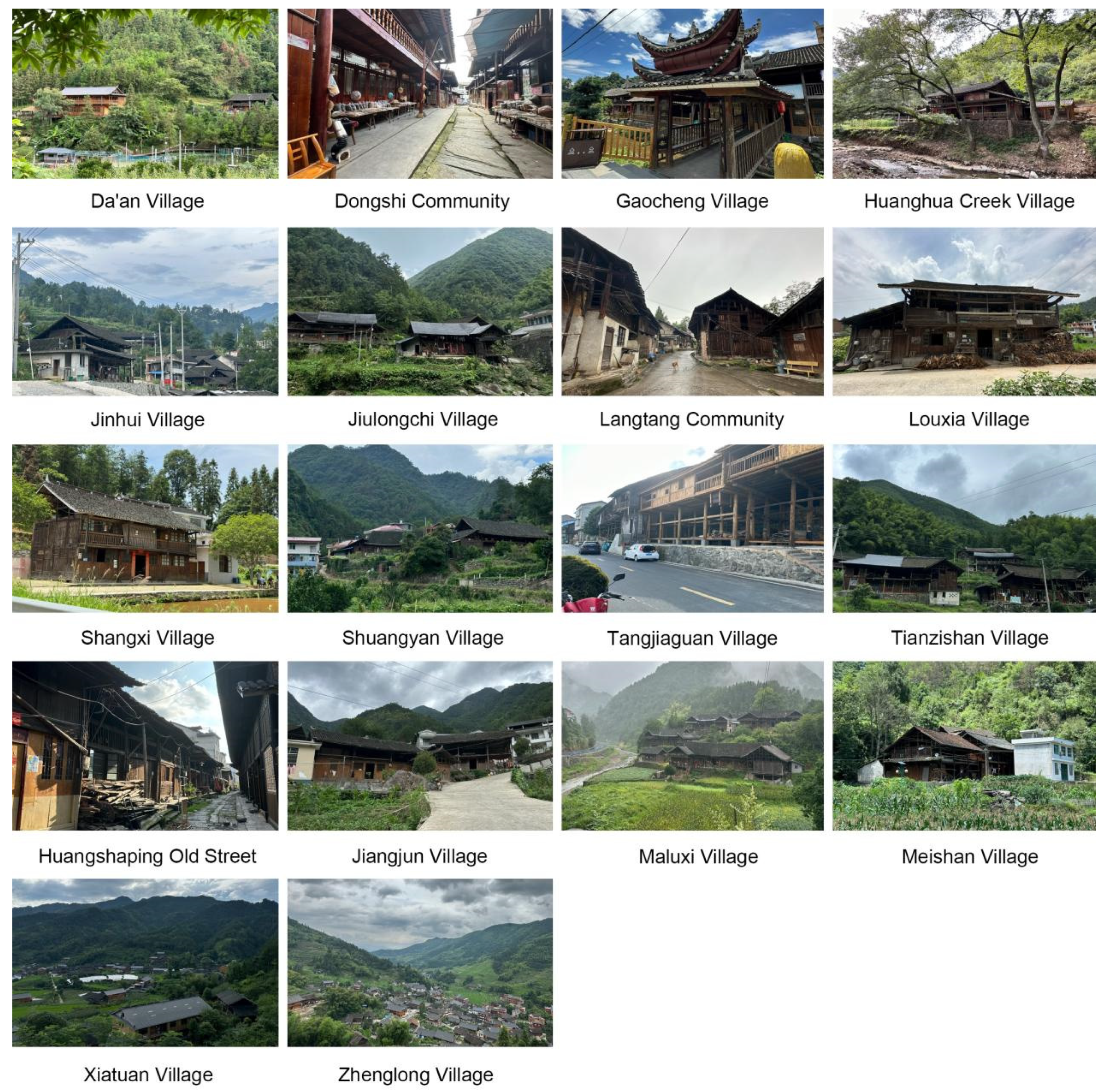
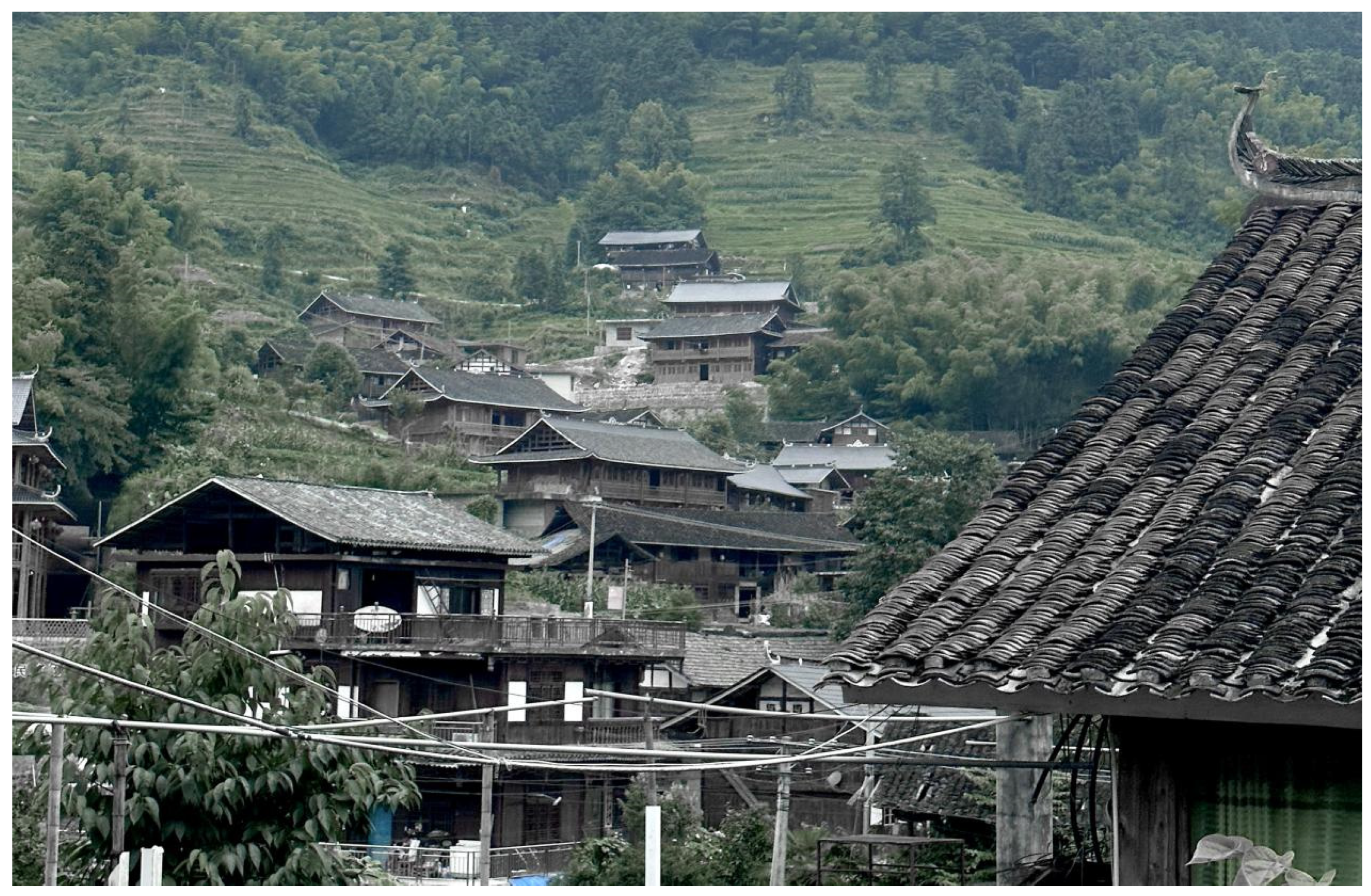
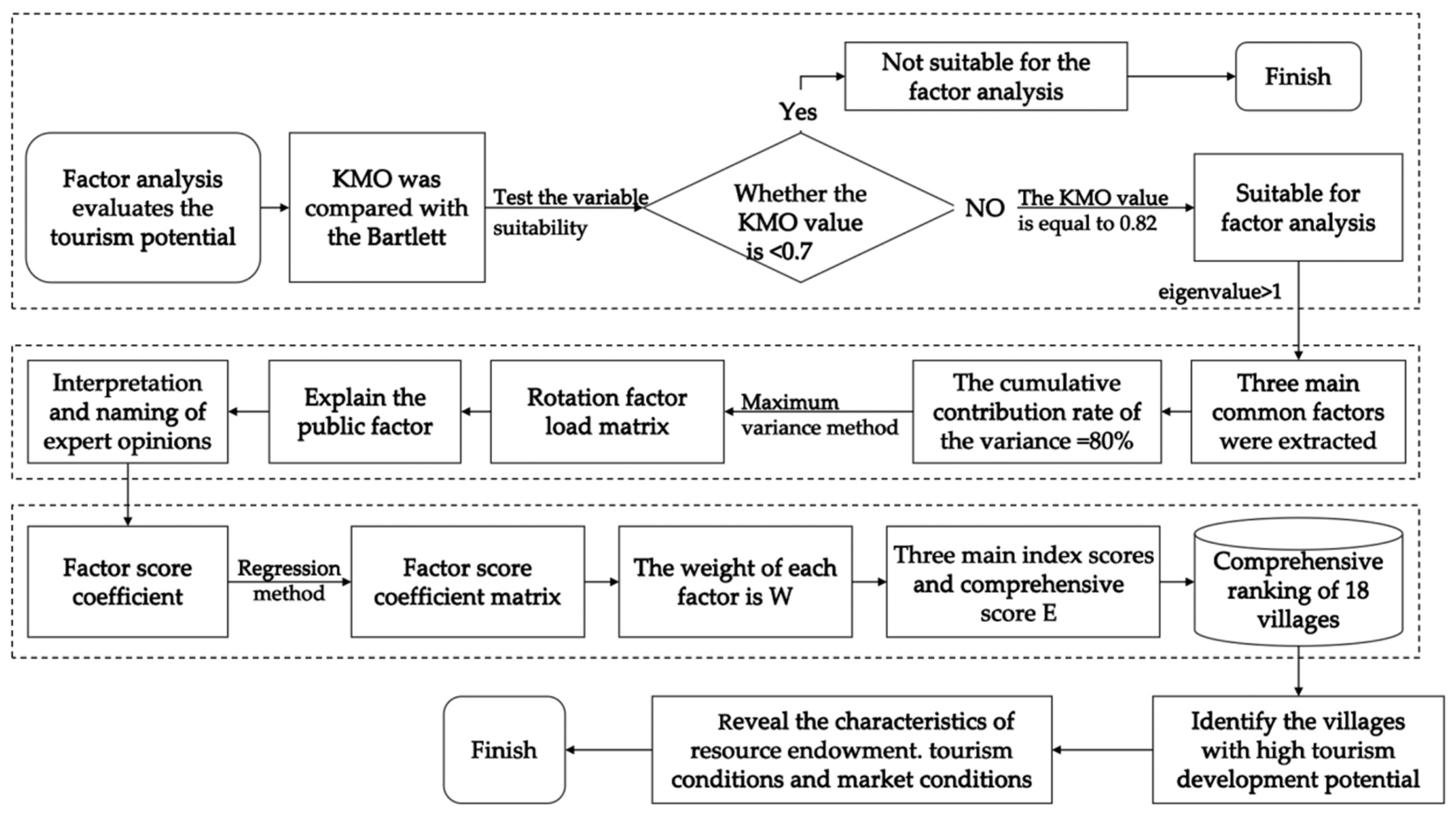
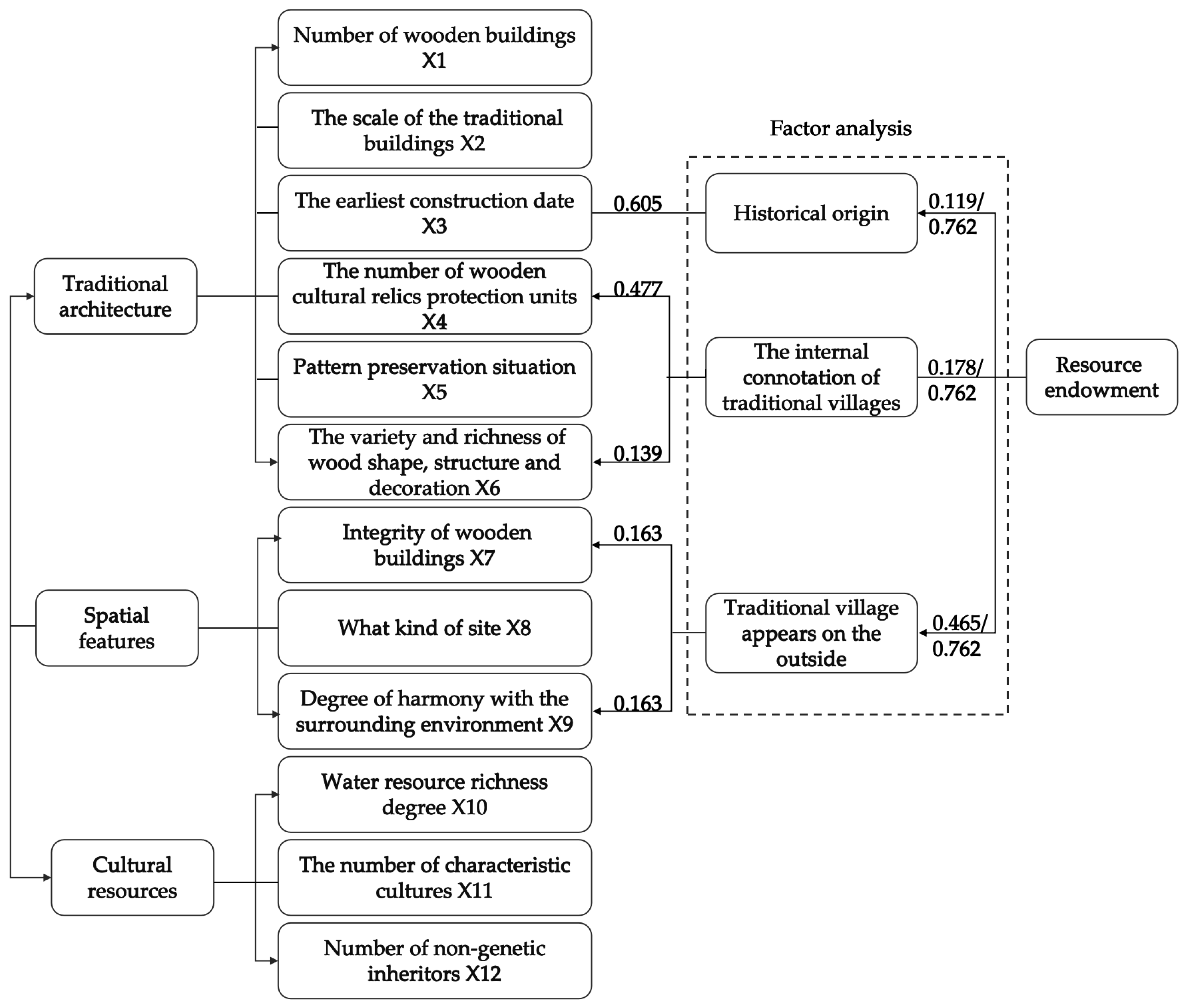
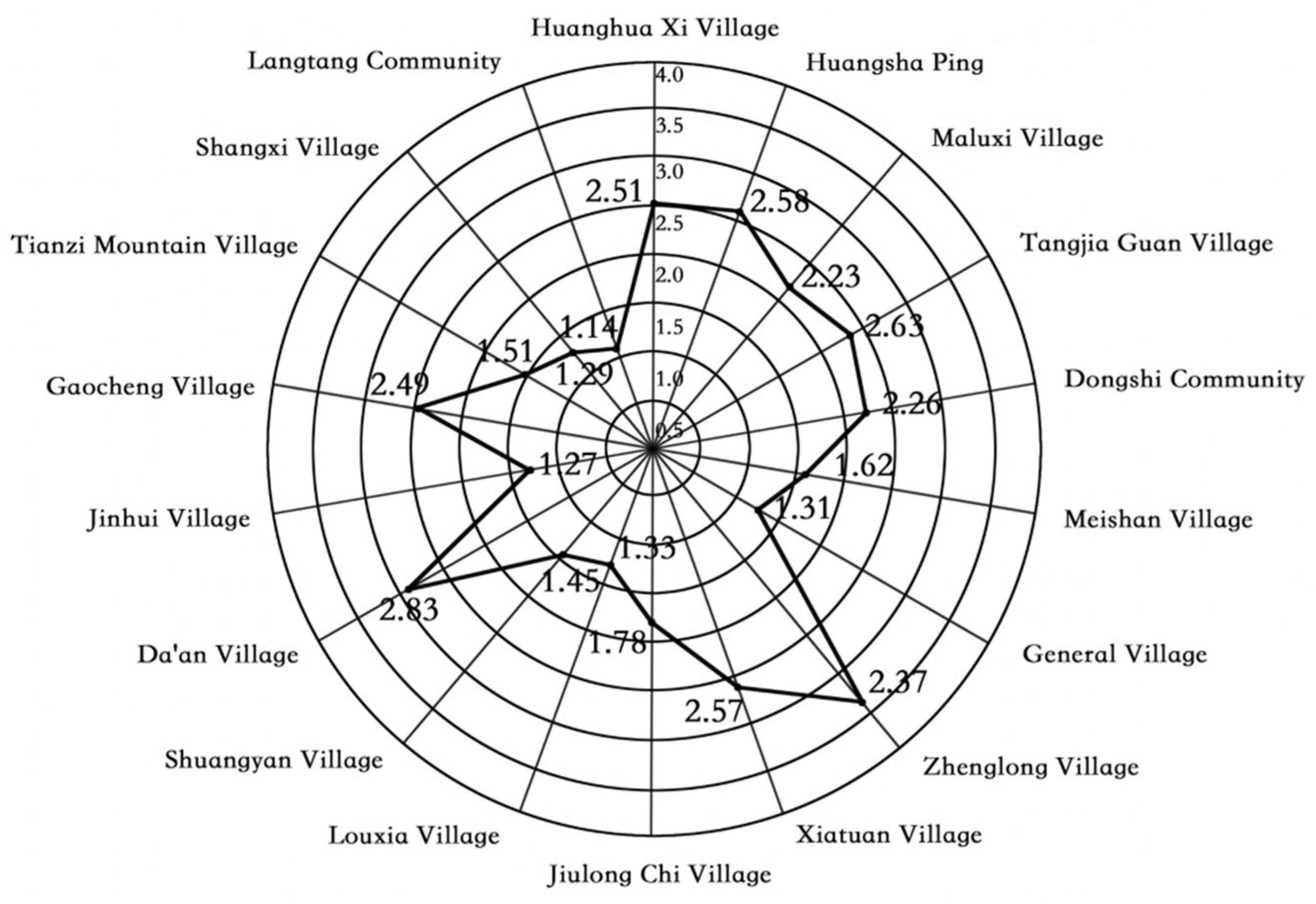
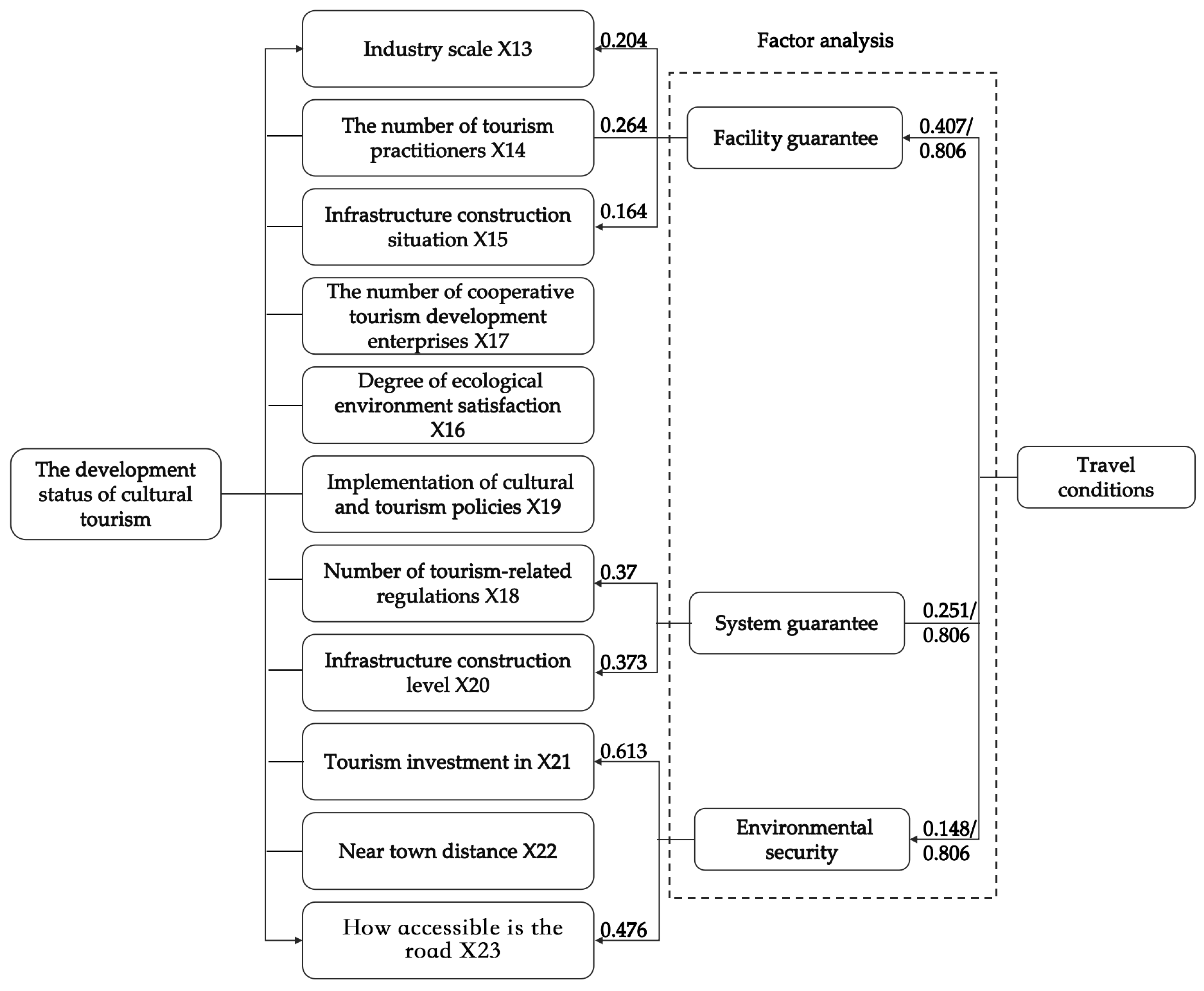
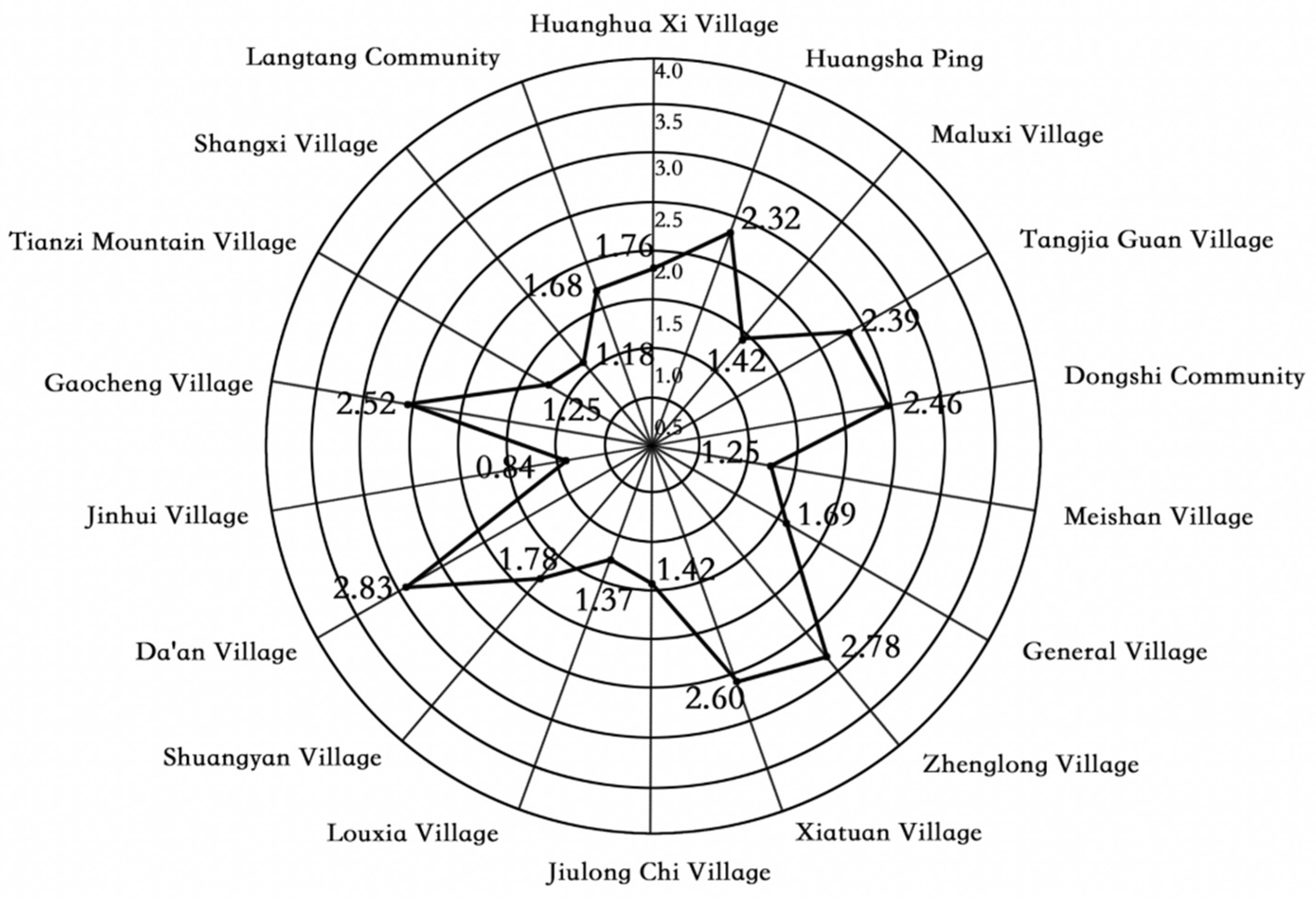
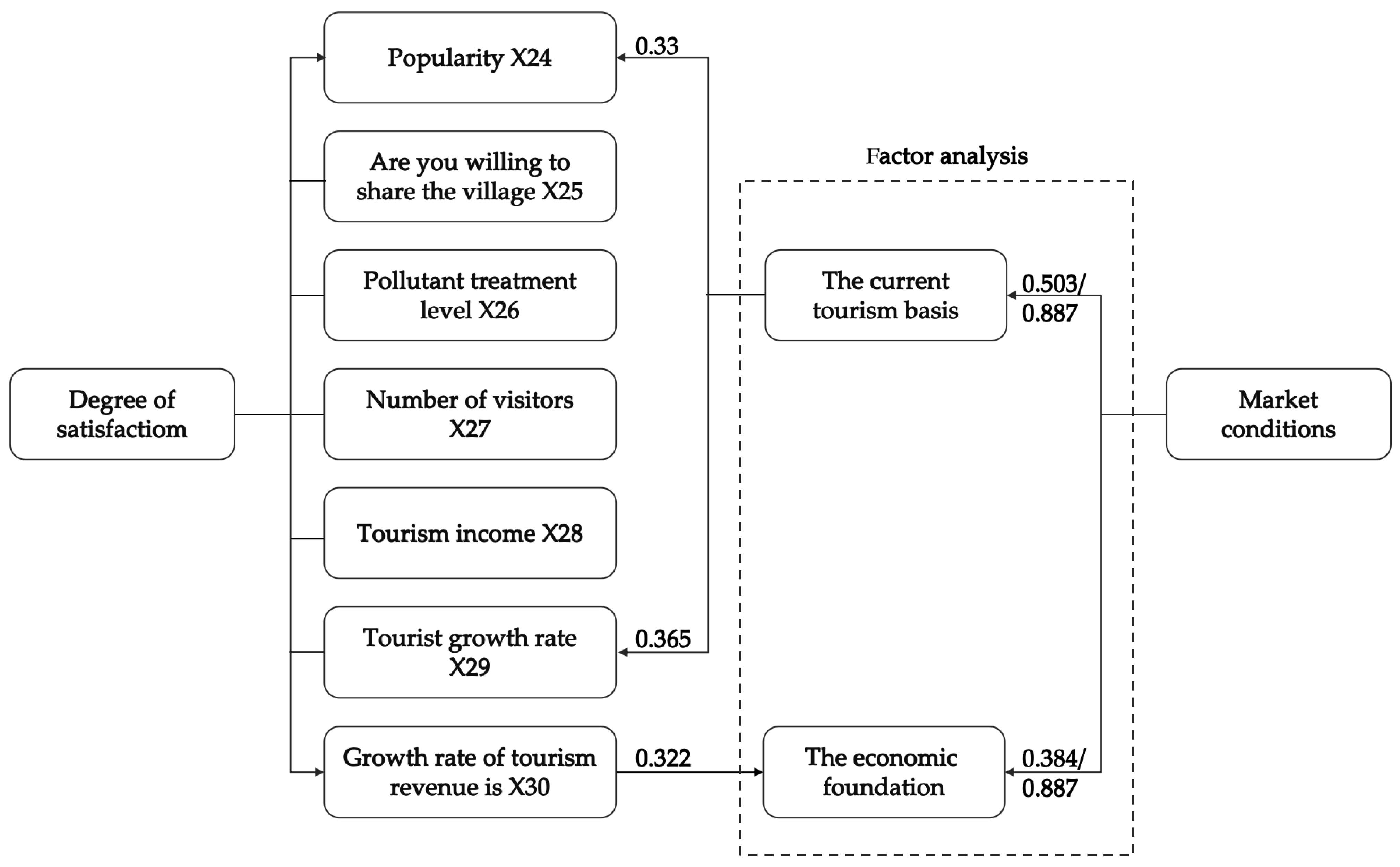
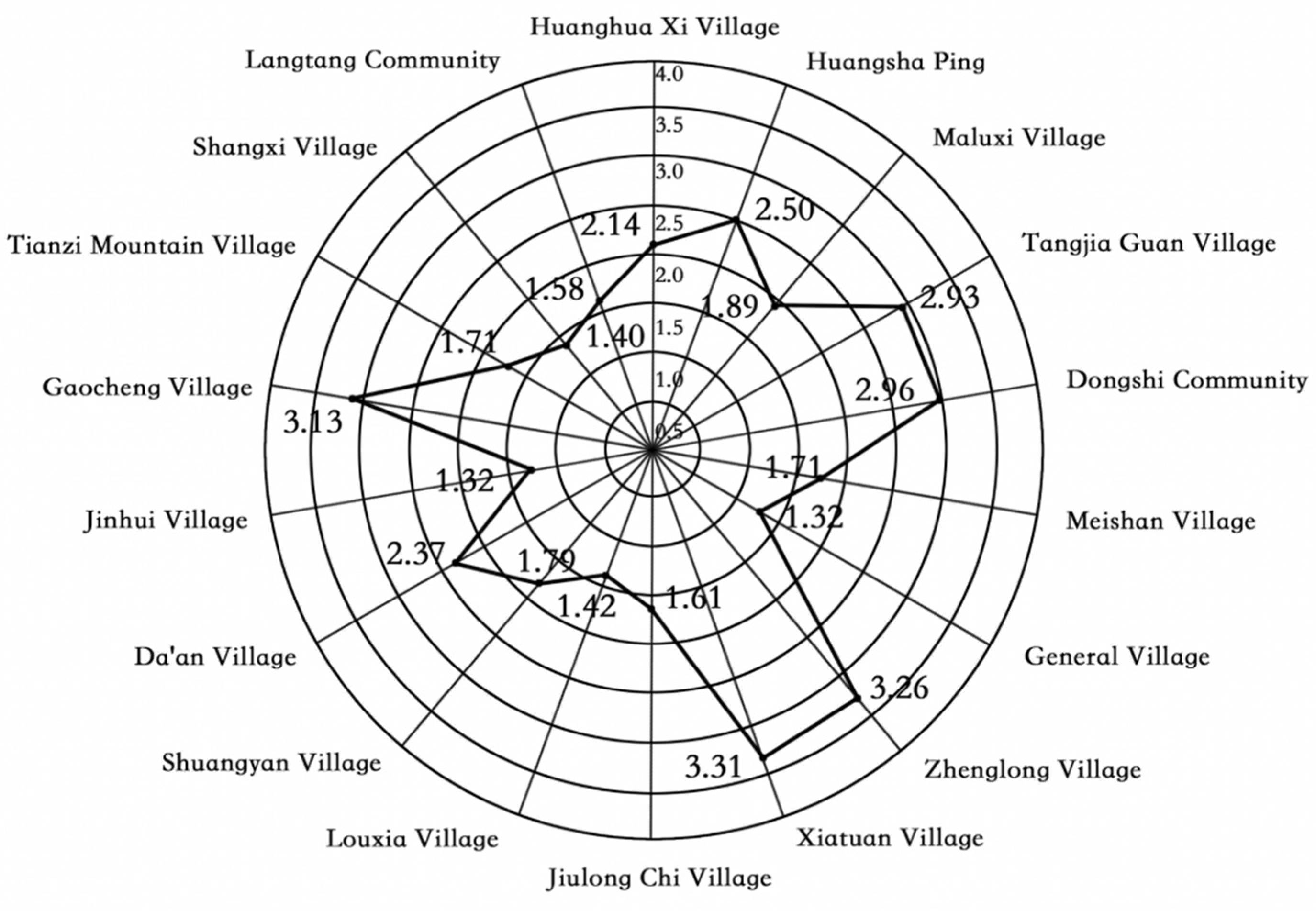
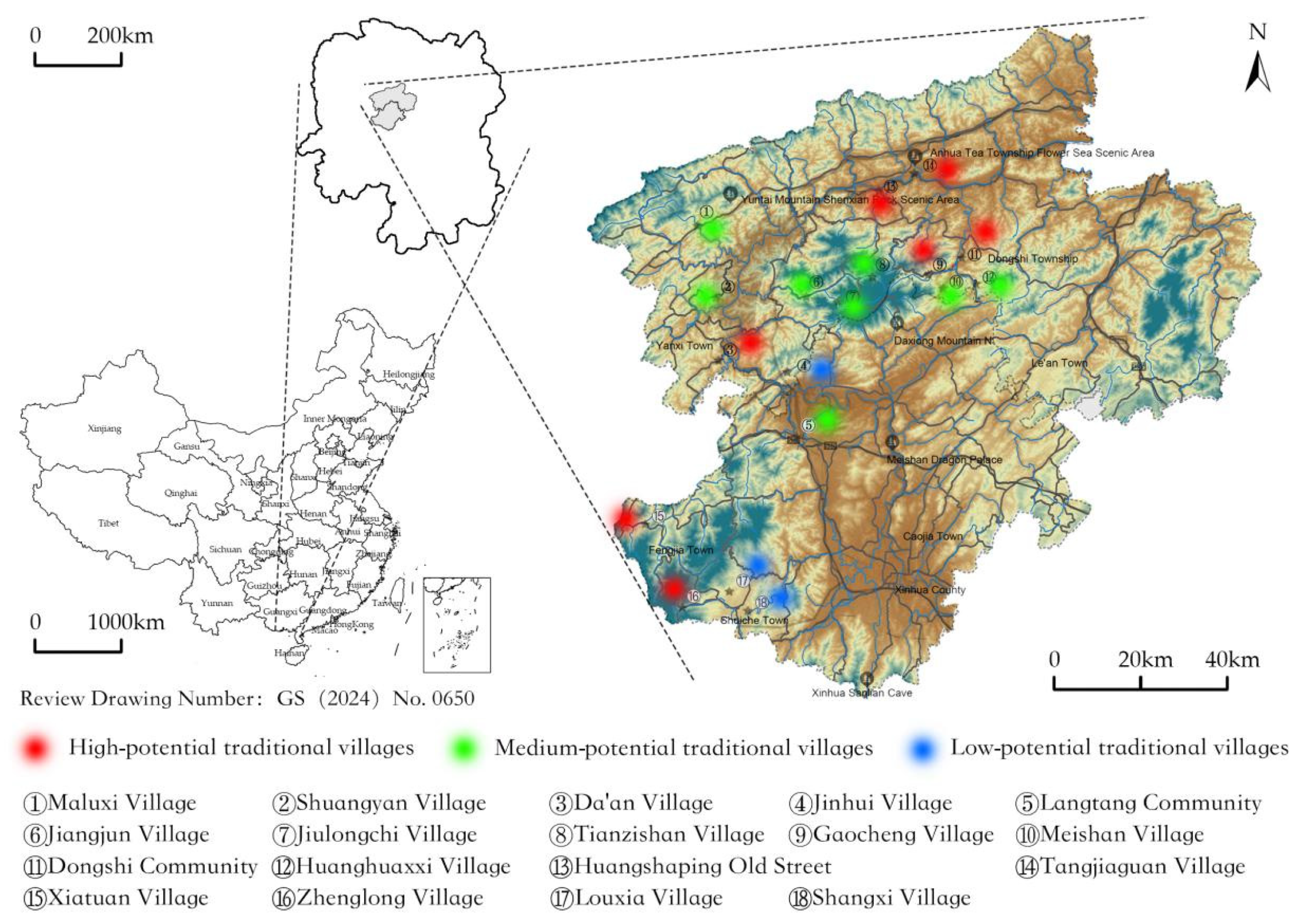
| Object | Total Number | Category | Description | Frequency | Percentage | Cumulative Percentage |
|---|---|---|---|---|---|---|
| villager | 600 | Gender | Female | 352 | 58.67% | 58.67% |
| Male | 248 | 41.33% | 100% | |||
| Age | 20 or under | 21 | 3.5% | 3.5% | ||
| 21–30 | 77 | 12.83% | 16.33% | |||
| 31–40 | 98 | 16.33% | 32.66% | |||
| 41–50 | 217 | 36.17% | 68.83% | |||
| 51 or above | 187 | 31.17% | 100% | |||
| Education level | Primary School or below | 258 | 43% | 43% | ||
| High School | 181 | 30.17% | 73.17% | |||
| Junior College | 141 | 23.5% | 96.67% | |||
| Bachelor’s Degree | 17 | 2.83% | 99.05% | |||
| Postgraduate or above | 3 | 0.5% | 100% | |||
| tourist | 200 | Gender | Female | 121 | 60.5% | 60.5% |
| Male | 79 | 39.5% | 100% | |||
| Age | 20 or under | 5 | 2.5% | 2.5% | ||
| 21–30 | 33 | 16.5% | 19% | |||
| 31–40 | 98 | 49% | 68% | |||
| 41–50 | 43 | 21.5% | 89.5% | |||
| 51 or above | 21 | 10.5% | 100% | |||
| Education level | Primary School or below | 3 | 1.5% | 1.5% | ||
| High School | 33 | 16.5% | 18% | |||
| Junior College | 61 | 30.5% | 48.5 | |||
| Bachelor’s Degree | 91 | 45.5% | 94% | |||
| Postgraduate or above | 12 | 6% | 100% |
| Secondary Indicators | Tertiary Indicators | Assignment Criteria | 1 Point | 2 Points | 3 Points | 4 Points | 5 Points |
|---|---|---|---|---|---|---|---|
| Traditional Architecture | Richness X1 | Number of traditional buildings such as ancient river channels, commercial streets, docks, residential buildings, and ancient roads (Unit: Category) | 1–2 | 3–4 | 5–6 | 7–8 | ≥9 |
| Scale X2 | Traditional building area (Unit: km2) | 10 | 11–15 | 16–20 | 21–25 | ≥26 | |
| Era X3 | The era when the oldest wooden structure in the village was built (Unit: Era) | Modern Times | Late Qing Dynasty | Mid Qing Dynasty | Early Qing Dynasty | Before the Ming Dynasty | |
| Conservation Unit X4 | City level: 1 point, Provincial level: 2 points, National level: 3 points, Total score (Unit: Points) | 1–2 | 3–4 | 5–6 | 7–8 | ≥9 | |
| Architectural Layout X5 | Types of wooden house floor plans such as “one”-shaped, “L”-shaped, “H”-shaped, etc. (Unit: Category) | 1 | 2 | 3 | 4 | ≥5 | |
| Details X6 | Number of wooden decorations such as door frames, window frames, etc. (Unit: Item) | 1–2 | 3–4 | 5–6 | 7–8 | ≥9 | |
| Site Selection and Layout | Integrity X7 | Percentage of modern buildings in the traditional building cluster area (Unit: Percentage) | ≥41% | 31–40% | 21–30% | 11–20% | ≤10% |
| Cultural Value X8 | Degree of manifestation of traditional Feng Shui culture such as “backing mountains and facing water”, “embracing Yin and Yang”, “adapting to local conditions”, etc. | Extremely Poor | Poor | Average | Good | Excellent | |
| Harmony X9 | The impact of site selection and layout on the ecological environment of the village | Very Large | Large | Medium | Small | Extremely Small | |
| Water Resources X10 | Number of water sources such as rivers, lakes, ponds, and mountain springs around the village (Unit: Item) | 1 | 2 | 3 | 4 | ≥5 | |
| Intangible Cultural Heritage | Folk Arts X11 | Number of folk arts such as traditional operas, shadow puppetry, and legends (Unit: Item) | 1 | 2 | 3 | 4 | ≥5 |
| Heritage Successors X12 | Number of inheritors of intangible cultural heritage (Unit: Person) | 1–2 | 3–4 | 5–6 | 7–8 | ≥9 |
| Secondary Indicators | Tertiary Indicators | Assignment Criteria | 1 Point | 2 Points | 3 Points | 4 Points | 5 Points |
|---|---|---|---|---|---|---|---|
| Reception Capacity | Industry Scale X13 | Number of hotels, restaurants, and small supermarkets | 1–2 | 3–4 | 5–6 | 7–8 | ≥9 |
| Employment Ratio X14 | Percentage of tourism Industry employees (Unit: Percentage) | ≤5 | 6–10 | 11–15 | 16–20 | ≥21 | |
| Living Environment | Facility Conditions X15 | Number of public toilets, clinics, and parking lots | 1–2 | 3–4 | 5–6 | 7–8 | ≥9 |
| Environmental Conditions X16 | Cleanliness of green spaces, road surfaces, and service facilities | Extremely Poor | Poor | Average | Good | Excellent | |
| Resident Happiness X17 | Impact of the tourism industry on local residents’ lives | Extremely Small | Small | Medium | Large | Extremely Large | |
| Government Support | Management Level X18 | Implementation of tourism policies | Extremely Poor | Poor | Average | Good | Excellent |
| Support Intensity X19 | Policy support and financial investment (Unit: CNY 10,000) | ≤50 | 51–100 | 101–150 | 151–200 | ≥200 | |
| Basic Investment X20 | Investment in infrastructure Construction (Unit: CNY 10,000) | ≤50 | 51–100 | 101–150 | 151–200 | ≥200 | |
| Tourism Investment X21 | Investment in tourism development (Unit: CNY 10,000) | ≤50 | 51–100 | 101–150 | 151–200 | ≥200 | |
| Location Conditions | Distance to Adjacent Towns X22 | Time required to drive to the county town (Unit: Hours) | ≥2.6 | 2.1–2.5 | 1.6–2 | 1–1.5 | ≤1 |
| Traffic Accessibility X23 | Percentage of village roads to higher administrative areas (Unit: Percentage) | ≥41 | 31–40 | 21–30 | 11–20 | ≤10 |
| Secondary Indicators | Tertiary Indicators | Assignment Criteria | 1 Point | 2 Points | 3 Points | 4 Points | 5 Points |
|---|---|---|---|---|---|---|---|
| Current Status of Village Development | Popularity X24 | Number of Well-Known Village Attractions (Unit: Number) | 1 | 2 | 3 | 4 | ≥5 |
| Reputation X25 | Tourist Satisfaction with Tourism (Unit: Satisfaction Level) | Extremely Poor | Poor | Average | Good | Excellent | |
| Economic Condition X26 | Total Output Value of Agriculture, Forestry, Animal Husbandry, and Fishery (Unit: CNY 10,000) | ≤1000 | 1001–1500 | 1501–2000 | 2001–2500 | ≥2501 | |
| Tourism Demand | Number of Tourists X27 | Number of Tourist Arrivals (Unit: People/Year) | ≤1000 | 1001–1500 | 1501–2000 | 2001–2500 | ≥2501 |
| Tourism Revenue X28 | Total Economic Consumption by Tourists in the Area (Unit: CNY 10,000/Year) | ≤50 | 51–100 | 101–200 | 201–300 | ≥301 | |
| Tourist Growth Rate X29 | Year-on-Year Growth in Tourism Numbers (Unit: Percentage) | ≤5 | 6–10 | 11–15 | 16–20 | ≥21 | |
| Revenue Growth Rate X30 | Year-on-Year Growth in Tourism Revenue (Unit: Percentage) | ≤5% | 6–10 | 11–15 | 16–20 | ≥21 |
Disclaimer/Publisher’s Note: The statements, opinions and data contained in all publications are solely those of the individual author(s) and contributor(s) and not of MDPI and/or the editor(s). MDPI and/or the editor(s) disclaim responsibility for any injury to people or property resulting from any ideas, methods, instructions or products referred to in the content. |
© 2025 by the authors. Licensee MDPI, Basel, Switzerland. This article is an open access article distributed under the terms and conditions of the Creative Commons Attribution (CC BY) license (https://creativecommons.org/licenses/by/4.0/).
Share and Cite
Zhang, S.; Li, Z.; Liu, S. Exploring the Tourism Development Potential and Distinctive Features of Traditional Wooden Architecture in Central Hunan: A Case Study of 18 Villages. Sustainability 2025, 17, 2573. https://doi.org/10.3390/su17062573
Zhang S, Li Z, Liu S. Exploring the Tourism Development Potential and Distinctive Features of Traditional Wooden Architecture in Central Hunan: A Case Study of 18 Villages. Sustainability. 2025; 17(6):2573. https://doi.org/10.3390/su17062573
Chicago/Turabian StyleZhang, Shuang, Zhirong Li, and Shaobo Liu. 2025. "Exploring the Tourism Development Potential and Distinctive Features of Traditional Wooden Architecture in Central Hunan: A Case Study of 18 Villages" Sustainability 17, no. 6: 2573. https://doi.org/10.3390/su17062573
APA StyleZhang, S., Li, Z., & Liu, S. (2025). Exploring the Tourism Development Potential and Distinctive Features of Traditional Wooden Architecture in Central Hunan: A Case Study of 18 Villages. Sustainability, 17(6), 2573. https://doi.org/10.3390/su17062573






